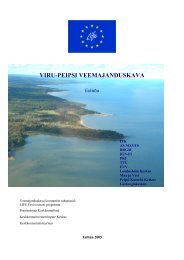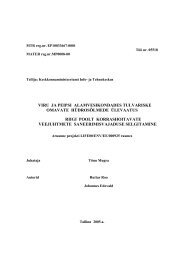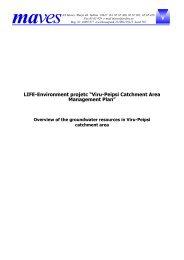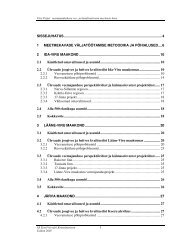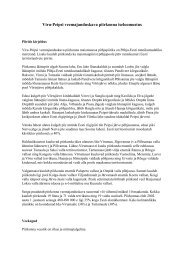open file - Viru Peipsi
open file - Viru Peipsi
open file - Viru Peipsi
You also want an ePaper? Increase the reach of your titles
YUMPU automatically turns print PDFs into web optimized ePapers that Google loves.
mm/day<br />
1.60<br />
1.40<br />
1.20<br />
1.00<br />
0.80<br />
0.60<br />
0.40<br />
0.20<br />
0.00<br />
Jan Feb Mar Apr May Jun Jul Aug Sep Oct Nov Dec Jan<br />
Baseline<br />
HADMID<br />
HADMIN<br />
HAMMID<br />
HAMMAX<br />
Fig. 1. Changes in monthly runoff in Võhandu River (station Räpina).<br />
Modelled data for Emajõgi River basin (Fig. 2) have the highest increase in<br />
runoff. But the predicted seasonal variations of discharge are quite similar to<br />
the previous example. The increase in winter runoff and its maximum in<br />
March in case of Emajõgi River basin is higher. It is caused by a fact that this<br />
river has the largest catchment area and runoff is naturally regulated by Lake<br />
Võrtsjärv.<br />
1.60<br />
1.40<br />
mm/day<br />
1.20<br />
1.00<br />
0.80<br />
0.60<br />
0.40<br />
0.20<br />
0.00<br />
Jan Feb Mar Apr May Jun Jul Aug Sep Oct Nov Dec Jan<br />
Baseline<br />
HADMID<br />
HADMIN<br />
HAMMID<br />
HAMMAX<br />
Fig. 2. Changes in monthly runoff in Emajõgi River basin (station Tartu).<br />
The Kunda River basin is typical to a limestone plateau and a karst region in<br />
North Estonia. It has a great groundwater inflow that makes slower the runoff<br />
decrease after spring maximum, and higher the level of runoff minimum in<br />
summer. Both the maximum in spring and minimum in summer will be shifted<br />
earlier in case of climate change (Fig. 3). The increase of runoff in autumn will<br />
be significant in Kunda River basin.



